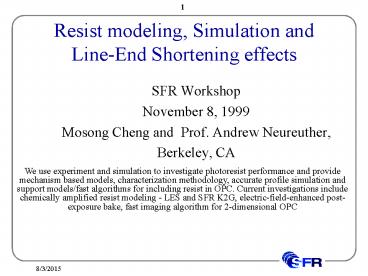Resist modeling, Simulation and Line-End Shortening effects PowerPoint PPT Presentation
Title: Resist modeling, Simulation and Line-End Shortening effects
1
Resist modeling, Simulation and Line-End
Shortening effects
- SFR Workshop
- November 8, 1999
- Mosong Cheng and Prof. Andrew Neureuther,
- Berkeley, CA
We use experiment and simulation to investigate
photoresist performance and provide mechanism
based models, characterization methodology,
accurate profile simulation and support
models/fast algorithms for including resist in
OPC. Current investigations include chemically
amplified resist modeling - LES and SFR K2G,
electric-field-enhanced post-exposure bake, fast
imaging algorithm for 2-dimensional OPC
2
Resist-model-based line-end shortening simulation
- APEX-E , UVIIHS, K2G parameter-extraction
methodology - Simulation flow
Problem Top to Top underestimates
diffusion Problem Microstepper at Berkeley has
insufficient image quality
3
K2G resist DRM curves and reaction/diffusion/outg
asing model
- DRM curves, dissolution rate is lower at the top
if no TARC.
Collaboration with Jacek Tyminski Nikon
- Reaction/diffusion/outgasing model
4
K2G resist modeling and simulation
- Modeling methodology
Extracting dissolution parameters
Large-area exposure
Extracting reaction rate
Resist profile simulation
Fitting with DRM data
Extracting diffusivity
- Fitting DRM curves
- Resist profile simulation
5
Electric-field-enhanced post-exposure bake
- Goal shorten PEB time, improve vertical resist
profile uniformity, reduce lateral acid
diffusion. - Principle vertical electric field enhance the
vertical movement of photoacid, hence enhance the
reaction cross-section. PEB time as well as
lateral acid diffusion can be reduced. - Experimental Setup
Al foil
wafer
Al foil
Hotplate
Resist
E
photoacid
6
Electric-field-enhanced post-exposure bake status
- Experiment done in summer 1999, on UVII resist
using JEOL.
RESIST
RESIST
- UVII resist, 0.5µm L/S, dose 20µC/cm2, PEB with
100kHz, 3.3V AC, 140oC, 60sec.
- UVII resist, 0.5µm L/S, dose 20µC/cm2, nominal
PEB,140oC, 90sec.
7
Fast resist imaging algorithm for 2-dimensional
OPC(submitted to SPIE99)
- Assume 2-D reaction/diffusion. Let
f(x,y,t)Cas(x,y,t), g(x,y,t)Ca(x,y,t).
Contains Spatial Laplacian and Uses 3rd Order
Splines
- Time-advancing scheme
Based on NT Aliasing and NL Relaxation
Very Fast as only requires repeated
multiplication with fixed coefficients
- Iterative solve c2,d2, to minimize the error E.
8
Fast resist imaging algorithm simulating flow
and tuning parameters
- Simulating and tuning flow
resist profile
Mask pattern
aerial image
Resist imaging
SPLAT
Resist parameter tuner
Differential
Method of Feasible Direction
SEM picture
- Extract resist parameters by tuning the image to
fit with SEM picture.
9
Targeted Opportunities in Resists and Tools 2000
- 2002
- Complete comparison of Simulation and SEM's of
printed features in K2G resist, quantify the
accuracy of the resist model. - Complete coding of the fast but approximate image
processing like algorithm and assess speed and
accuracy against rigorous simulation in STORM. - Initiate tool-process-dependent line-end
shortening investigation by identifying key
factors contributing to line-end shortening and
suggesting approaches for control and
compensation tuning.

